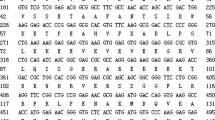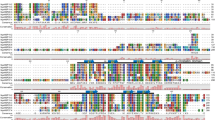Abstract
Thermotolerance, or the ability of organisms to withstand exposure to potentially lethal high temperatures, is thought to be conferred by the induction of heat shock proteins (HSPs) (Lindquist 1986). Several major families of HSPs classified according to molecular weight and amino acid similarity have been defined, although how they contribute to the development of thermotolerance is not well understood. Among the HSPs most highly induced by heat stress in eukaryotes is a class of nuclear-encoded proteins ranging in size from 15 to 30 kD referred to as the small HSPs (sHSPs). Though diverse in size and primary structure, the sHSPs can be identified based on their similar hydropathy profiles and homology to the acrystallin proteins of the eye lens (Lindquist and Craig 1988).
Access this chapter
Tax calculation will be finalised at checkout
Purchases are for personal use only
Preview
Unable to display preview. Download preview PDF.
Similar content being viewed by others
References
Ainley WM, Key JL (1990) Development of a heat shock inducible expression cassette for plants: Characterization of parameters for its use in transient expression assays. Plant Mol Biol 14: 949–967
Altschuler M, Mascarenhas JP (1982) Heat shock proteins and effects of heat shock in plants. Plant Mol Biol 1: 103–115
Anderson LO, Borg H, Mikaelsson M (1972) Molecular weight estimation of proteins by electrophoresis in polyacrylamide gels of graded porosity. FEBS Lett 20: 199–202
Arrigo A-P, Welch WJ (1987) Characterization and purification of the small 28,000-dalton mammalian heat shock protein. J Biol Chem 262: 15359–15369
Binelli G, Mascarenhas JP (1990) Arabidopsis: Sensitivity of growth to high temperature. Dev Genet 11: 294–298
Chen Q (1992) The major chloroplast low molecular weight heat shock protein. PhD Dissertation, University of Arizona, Tucson, AZ
Chen Q, Lauzon LM, DeRocher AE, Vierling E (1990) Accumulation, stability, and localization of a major chloroplast heat-shock protein. J Cell Biol 110: 1873–1883
Chen Q, Vierling E (1991) Analysis of conserved domains identifies a unique structural feature of a chloroplast heat shock protein. Mol Gen Genet 226: 425–431
Collier NC, Heuser J, Levy MA, Schlesinger MJ (1988) Ultrastructural and biochemical analysis of the stress granule in chicken embryo fibroblasts. J Cell Biol 106: 1131–1139
DeRocher AE, Helm KW, Lauzon LM, Vierling E (1991) Expression of a conserved family of cytoplasmic low molecular weight heat shock proteins during heat stress and recovery. Plant Physiol 96: 1038–1047
Gething M-J, Sambrook J (1992) Protein folding in the cell. Nature 355: 33–45
Helm KW, LaFayette PR, Nagao RT, Key JL, Vierling E (1993) Localization of small HSPs to the higher plant endomembrane system. Mol Cell Biol 13: 238–247
Horwitz J (1992) a-Crystallin can function as a molecular chaperone. Proc Natl Acad Sci USA 89:10449–10453
Howarth CJ (1991) Molecular reponses of plants to an increased incidence of heat shock. Plant, Cell Environ 14: 831–841
Jakob U, Gaestel M, Engel K, Buchner J (1993) Small heat shock proteins are molecular chaperones. J Biol Chem 268: 1517–1520
Kimpel JA, Nagao RT, Goekjian V, Key JL (1990) Regulation of the heat shock response in soybean seedlings. Plant Physiol 94: 988–995
Kloppstech K, Meyer G, Schuster G, Ohad I (1985) Synthesis, transport and localization of a nuclear coded 22-kd heatshock protein in the chloroplast membranes of peas and Chlamydomonas reinhardi. EMBO J 4: 1902–1909
Lindquist S (1986) The heat shock response. Annu Rev Biochem 45: 39–72
Lindquist S, Craig EA (1988) The heat shock proteins. Annu Rev Genet 22: 631–677
Marton L, Browse J (1991) Facile transformation of Arabidopsis. Plant Cell Reports 10: 235–239
Nieto-Sotolo J, Vierling E, Ho T-H D (1990) Cloning, sequence analysis and expression of a cDNA encoding a plastid localized heat shock protein in maize. Plant Physiol 93: 1321–1328
Nover L, Scharf K-D, Neumann D (1989) Cytoplasmic heat shock granules are formed from precursor perticles and are associated with a specific set of mRNAs. Mol Cell Biol 9: 1298–1308
Odell JT, Nagy F, Chua N-H (1985) Identification of DNA sequences required for activity of the cauliflower mosaic virus 35S promoter. Nature 313: 810–812
Osteryoung KW, Sundberg H, Vierling E (1993) Poly(A) tail length of a heat shock protein RNA is increased by severe heat stress, but intron splicing is unaffected. Mol Gen Genet, 239: 323–333.
Osteryoung KW, Vierling E (1992) Genetic approaches to the function of the chloroplast low molecular weight heat shock protein. In N Murata, ed, Research in Photosynthesis. Kluwer Academic Publishers, Dordrecht, Netherlands Vol IV:129–136
Rogers SG, Horsch RB, Fraley RT (1986) Gene transfer in plants: production of transformed plants using Ti plasmid vectors. Methods Enzymol, 118: 627–641
Rogers SG, Klee HJ, Horsch RB, Fraley RT (1987) Improved vectors for plant transformation: Expression cassette vectors and new selectable markers. Meth Enzymol 153: 253–277
Sanchez Y, Lindquist SL (1990) HSP104 is required for induced thermotolerance. Science 248: 1112–1115
Valvekens D, Van Montagu M, Van Lijsebettens M (1988) Agrobacterium tumefaciens-mediated transformation of Arabidopsis thaliana root explants by using kanamycin selection. Proc Natl Acad Sci 85: 5536–5540
Vierling E (1991) The roles of heat shock proteins in plants. Annu Rev Plant Physiol Plant Mol Biol 42: 579–620
Vierling E, Mishkind ML, Schmidt GW, Key JL (1986) Specific heat shock proteins are transported into chloroplasts. Proc Natl Acad Sci USA 83: 361–365
Vierling E, Nagao RT, DeRocher AE, Harris LM (1988) A heat shock protein localized to chloroplasts is a member of a eukaryotic superfamlily of heat shock proteins. EMBO J 7: 575–581
Watson CF, Grierson D (1993) Antisense RNA in plants. In A Hiatt, ed, Transgenic Plants: Fundamentals and Applications. Marcel Dekker, New York, pp 255–281
Weng J, Wang Z, Nguyen HT (1991) Nucleotide sequence of a Triticum aestivum cDNA clone which is homologous to the 26 kDa chloroplast-localized heat shock protein gene of maize. Plant Mol Biol 17: 255
Author information
Authors and Affiliations
Editor information
Editors and Affiliations
Rights and permissions
Copyright information
© 1994 Springer-Verlag Berlin Heidelberg
About this paper
Cite this paper
Osteryoung, K.W., Pipes, B., Wehmeyer, N., Vierling, E. (1994). Studies of a Chloroplast-Localized Small Heat Shock Protein in Arabidopsis . In: Cherry, J.H. (eds) Biochemical and Cellular Mechanisms of Stress Tolerance in Plants. NATO ASI Series, vol 86. Springer, Berlin, Heidelberg. https://doi.org/10.1007/978-3-642-79133-8_5
Download citation
DOI: https://doi.org/10.1007/978-3-642-79133-8_5
Publisher Name: Springer, Berlin, Heidelberg
Print ISBN: 978-3-642-79135-2
Online ISBN: 978-3-642-79133-8
eBook Packages: Springer Book Archive




